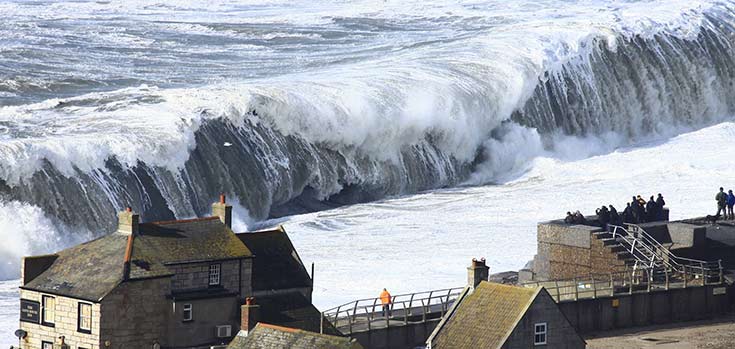Winter storms the most energetic to hit western Europe since 1948, study shows
The repeated storms that battered Europe's Atlantic coastline during the winter of 2013/14 were the most energetic in almost seven decades, new research has shown.

February 5, 2014: Extreme waves striking Chesil Beach in Dorset, UK (photo: Richard Broome)
These storms were part of a growing trend in stormy conditions which scientists say has the potential to change the equilibrium state of beaches along the western side of the continent dramatically, leading to permanent changes in beach gradient, coastal alignment and nearshore bar position.
In a study accepted for publication in Geophysical Research Letters, a journal of the American Geophysical Union, researchers compared modelled and measured data from sites across Scotland, Ireland, England, France, Portugal, Spain and Morocco, and showed the extreme weather conditions were the most energetic since at least 1948.
It showed that along exposed open-coast sites in the UK and France, there had been extensive beach and dune erosion owing to offshore sediment transport with sediment losses of up to 200 cubic metres for every one metre strip of beach. At some of the other sites, the balance between the different alongshore sediment transport contributions was disrupted, causing changes in the coastal alignment, referred to as beach rotation.
The research was led by Plymouth University (UK), in conjunction with scientists from the Centre National de la Recherche Scientifique, l'Université de Bordeaux, l'Institut Universitaire Européen de la Mer (France) and Ulster University (Northern Ireland).
Gerd Masselink, Professor of Coastal Geomorphology at Plymouth University and the study's lead author, said: "We have previously conducted research showing the devastating effects caused to the UK by the stormy winter of 2013/14. But the damage caused to coastal communities there was replicated - and in some cases exceeded – across western France. All but one of the sites assessed for this study reached their most depleted state at the end of the 2014 winter, and it will take many years for them to fully recover."
For the study, researchers used a combination of modelled and measured wave data from the eastern Atlantic, stretching from Morocco to northwest Scotland, and also analysed long-term beach profile data from sites in Ireland, UK and France.
It showed that extreme wave conditions occurred up to five times more frequently in 2013/14, and winter wave heights were up to 40 per cent higher, than on average.
Dr Tim Scott, Lecturer in Ocean Exploration at Plymouth University, added: "The extreme winter of 2013/14 is in line with historical trends in wave conditions and is also predicted to increasingly occur due to climate change according to some of the climate models, with the winter of 2015/16 also set to be among the stormiest of the past 70 years. Whether due to more intense and/or more frequent storms, it should undoubtedly be considered in future coastal and sea defence planning along the Atlantic coast of Europe."
The next issue of CRJ (11:3) features an article by Dr Aurélie Duchez, looking at the effects of anomalous surface temperatures in the North Atlantic Ocean on extreme weather events.